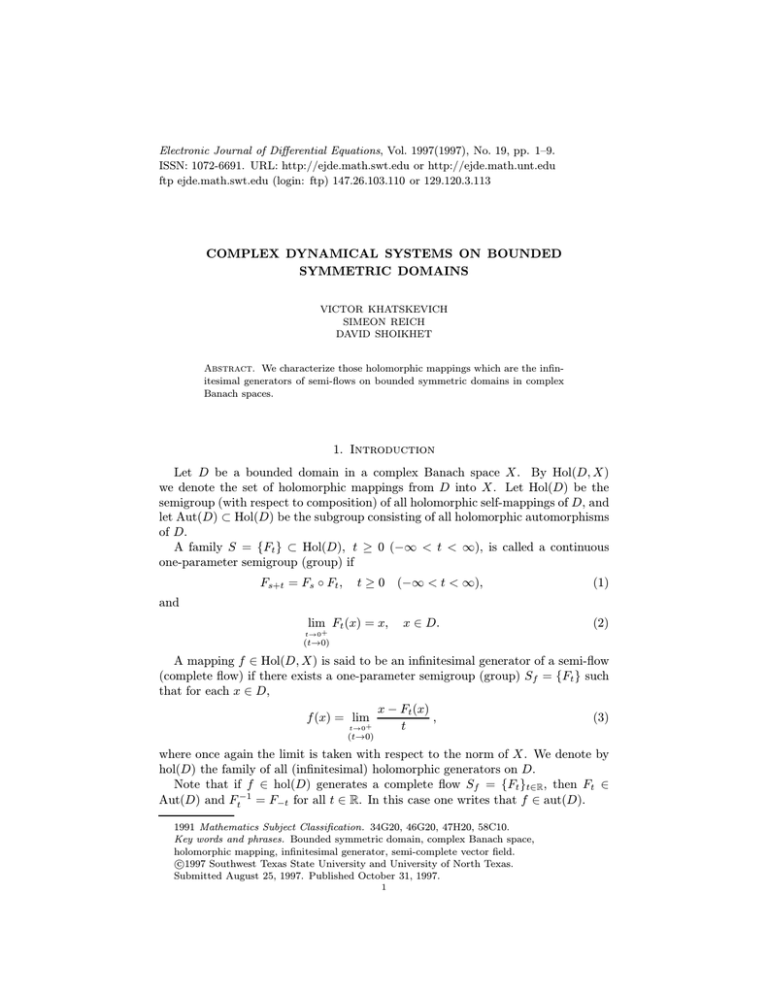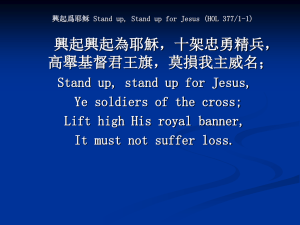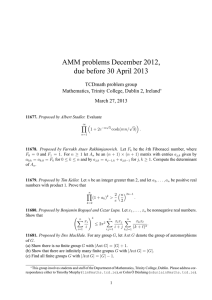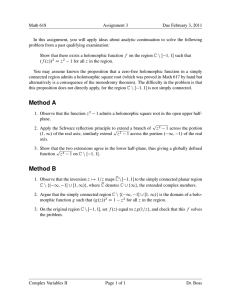Electronic Journal of Differential Equations, Vol. 1997(1997), No. 19, pp.... ISSN: 1072-6691. URL: or
advertisement

Electronic Journal of Differential Equations, Vol. 1997(1997), No. 19, pp. 1–9.
ISSN: 1072-6691. URL: http://ejde.math.swt.edu or http://ejde.math.unt.edu
ftp ejde.math.swt.edu (login: ftp) 147.26.103.110 or 129.120.3.113
COMPLEX DYNAMICAL SYSTEMS ON BOUNDED
SYMMETRIC DOMAINS
VICTOR KHATSKEVICH
SIMEON REICH
DAVID SHOIKHET
Abstract. We characterize those holomorphic mappings which are the infinitesimal generators of semi-flows on bounded symmetric domains in complex
Banach spaces.
1. Introduction
Let D be a bounded domain in a complex Banach space X. By Hol(D, X)
we denote the set of holomorphic mappings from D into X. Let Hol(D) be the
semigroup (with respect to composition) of all holomorphic self-mappings of D, and
let Aut(D) ⊂ Hol(D) be the subgroup consisting of all holomorphic automorphisms
of D.
A family S = {Ft } ⊂ Hol(D), t ≥ 0 (−∞ < t < ∞), is called a continuous
one-parameter semigroup (group) if
Fs+t = Fs ◦ Ft ,
t ≥ 0 (−∞ < t < ∞),
(1)
x ∈ D.
(2)
and
lim Ft (x) = x,
t→0+
(t→0)
A mapping f ∈ Hol(D, X) is said to be an infinitesimal generator of a semi-flow
(complete flow) if there exists a one-parameter semigroup (group) Sf = {Ft } such
that for each x ∈ D,
x − Ft (x)
f (x) = lim
,
(3)
t
t→0+
(t→0)
where once again the limit is taken with respect to the norm of X. We denote by
hol(D) the family of all (infinitesimal) holomorphic generators on D.
Note that if f ∈ hol(D) generates a complete flow Sf = {Ft }t∈R , then Ft ∈
Aut(D) and Ft−1 = F−t for all t ∈ R. In this case one writes that f ∈ aut(D).
1991 Mathematics Subject Classification. 34G20, 46G20, 47H20, 58C10.
Key words and phrases. Bounded symmetric domain, complex Banach space,
holomorphic mapping, infinitesimal generator, semi-complete vector field.
c
1997
Southwest Texas State University and University of North Texas.
Submitted August 25, 1997. Published October 31, 1997.
1
2
VICTOR KHATSKEVICH, SIMEON REICH & DAVID SHOIKHET
EJDE–1997/19
It can be shown (see, for example, [10] and [11]) that since f ∈ hol(D) is locally
bounded on D, the Cauchy problem
(
∂u(t,x)
+ f (u(t, x)) = 0
∂t
(4)
u(0, x) = x, x ∈ D,
can be solved on R+ = [0, ∞) for each x ∈ D and u(t, x) = Ft (x). Thus (4) defines
an analytic dynamical system and Sf = {Ft }t≥0 is a uniquely defined semi-flow on
D.
Moreover, the convergence in (2) is uniform on each ball strictly inside D. If, in
addition, f ∈ aut(D), then the Cauchy problem (4) can be solved for all t ∈ R =
(−∞, ∞).
Note also that if g ∈ Hol(D, X), then by allowing f to operate on g by means of
the formula (f g)(x) = g 0 (x) ◦ f (x) we can interpret f as a derivation of Hol(D, X),
i.e., as a holomorphic vector field. Using this terminology, f ∈ hol(D) will be
called a semi-complete vector field, and f ∈ aut(D) a complete vector field (see,
for example, [7], [6], [13] and [10]). It is known that aut(D) is a real Banach Lie
algebra, while hol(D) is only a real cone (see [1], [10] and [11]).
Our purpose in this paper is to describe the class of semi-complete vector fields
on a bounded symmetric domain. To motivate our approach we briefly review some
previous results.
For the one-dimensional case, namely, D = ∆, the open unit disk in the complex plane C, an implicit condition which characterizes hol(∆) was obtained by E.
Berkson and H. Porta [4].
It was shown by M. Abate [1] that their condition can be rewritten explicitly in
the form
1
Re f (x)x̄ ≥ − Re f 0 (x)(1 − |x|2 ).
(5)
2
As a matter of fact, this condition is the special case n = 1 of a more general (and
more complicated) condition, which is valid for the open Euclidean unit ball in Cn
(see [1]).
On the other hand, it follows directly from the definition, that if f ∈ hol(D) has
¯ then
a continuous extension to ∆,
Re f (x)x̄ ≥ 0
for all x ∈ ∂∆.
(6)
Unfortunately, it is not clear how to derive (6) from (5) in such a situation. At the
same time, by rewriting (6) in the form
Re [f (x) − f (0)]x̄ ≥ −Re f (0)x̄,
and dividing the left-hand side by |x|2 = 1, we get
f (x) − f (0)
Re
≥ −Re f (0)x,
x
x ∈ ∂∆.
Now it follows by the maximum principle for harmonic functions that the last
inequality holds also for x ∈ ∆. Multiplying it by |x|2 , x ∈ ∆, x 6= 0, we obtain
Re f (x)x̄ ≥ Re f (0)x̄(1 − |x|2 ), x ∈ ∆.
(7)
¯ condition
We claim that even if f ∈ Hol(∆, C) does not extend continuously to ∆,
(7) is necessary and sufficient for f to be an infinitesimal generator of a semi-flow.
EJDE–1997/19
COMPLEX DYNAMICAL SYSTEMS
3
Indeed, for the case of the open unit ball B in a Hilbert space H, it was shown
in [11], by using its hyperbolic metric, that the condition
Re hf (x), xi ≥ Re hf (0), xi(1 − kxk2 ), x ∈ B,
(8)
where h·, ·i is the inner product in H, characterizes the class hol(B).
Note that a crucial point of the approach in [11] was the smoothness of the
boundary of B. It is clear that such a property is no longer valid for the finite
product B n equipped with the max norm, and all the more so for the open unit
ball in L(H, H), the space of bounded linear operators from H into H.
Another technical way to extend (8) to B n , by using a special curve defined by
a family of Möbius transformations, was employed in [12].
Therefore a natural idea which arises is that this be done for each Banach space
X the open unit ball D of which is a homogeneous domain (i.e., for each pair
x, y ∈ D there is F ∈ Aut(D) such that F (x) = y).
Indeed, since every such ball is a bounded symmetric domain (see the definition
below), one can propose using the more general and well-developed theory of such
domains to derive an analog of condition (8) which will characterize hol(D).
It will become clear that such an approach does not require difficult calculations,
and moreover, it establishes new facts concerning the description of semi-complete
vector fields.
A domain D is called symmetric if for all a ∈ D there exists Fa ∈ Aut(D) such
that Fa2 = ID and a is an isolated fixed point of Fa .
For the case when D is a bounded symetric domain, the class aut(D) of all
complete vector fields on D has been well-described with the help of an algebraic
approach (see, for example, [7], [13], [3] and [6]). Namely, it is known that aut(D)
is a real Banach Lie algebra and each f ∈ aut(D) is a polynomial of degree at most
2. Moreover, if
p = {f ∈ aut(D) : f 0 (0) = 0}
(9)
k = {f ∈ aut(D) : f (0) = 0},
(10)
and
then aut(D) is the direct sum decomposition
aut(D) = p ⊕ k,
and each element of X can be realized as the constant term of a unique element of
p, i.e., for each y ∈ X there is a unique two-homogeneous polynomial Py such that
the mapping gy ∈ Hol(X, X) defined by the formula
gy (x) = y + Py (x)
(11)
belongs to p ⊂ aut(D).
Furthermore, by Kaup’s theorem [8], every bounded symmetric domain D can
be realized as the open unit ball of a JB ∗ -triple system, and moreover, it is a
homogeneous domain, i.e., for each pair x, y ∈ D there is F ∈ Aut(D) such that
F (x) = y.
Note also that an automorphism which moves the origin to y ∈ D can be generated by g ∈ p ⊂ aut(D), i.e., g has the form (11) (see, for example, [13] and
[6]).
So, in the sequel we will always assume that a bounded symmetric domain is
realized as a convex balanced domain. At the same time, in this case the gauge
4
VICTOR KHATSKEVICH, SIMEON REICH & DAVID SHOIKHET
EJDE–1997/19
of D (the Minkowski functional) can be defined as cD (0, ·), where cD (·, ·) is the
infinitesimal Carathéodory metric on D, and D is the indicatrix of this gauge, i.e.,
D = {x ∈ X : cD (0, x) < 1}.
Thus, since D is bounded, cD (0, ·) is a norm which is equivalent to the norm of
X, and D can be considered the open unit ball of X when it is equipped with this
norm. So, our problem may be formulated as follows.
Let X be a complex Banach space such that the open unit ball D of X is a
homogeneous domain. What are the geometric conditions which characterize semicomplete vector fields on D?
Let X 0 be the dual space of X. As usual, we use the pairing hx, x0 i to denote
the action of a linear functional x0 ∈ X 0 on an element x ∈ X. In particular, for
X = H, a Hilbert space, h·, ·i means the inner product in H. Recall also that the
0
normalized duality mapping J : X → 2X is defined by
J(x) = {x0 ∈ X 0 : hx, x0 i = kxk2 = kx0 k2 }.
2. Main result
Theorem 1. Let X be a complex Banach space such that the open unit ball D of
X is a homogeneous domain. Then the following assertions hold:
1. If f ∈ hol(D), then for each x ∈ D and for each x0 ∈ J(x),
Re hf (x), x0 i ≥ Re hf (0), x0 i(1 − kxk2 ).
(12)
2. If f ∈ Hol(D, X) is bounded on each subset strictly inside D and for each
x ∈ D there exists x0 ∈ J(x) such that (12) holds, then f ∈ hol(D).
3. If f ∈ hol(D) and Sf = {Ft }t≥0 is the semi-flow generated by f , then Ft ∈
Hol(D) satisfies the following estimate:
kFt (x)k ≤
kxk + 1 − e−2kf (0)kt (1 − kxk)
.
kxk + 1 + e−2kf (0)kt (1 − kxk)
(13)
To prove our theorem we need several preliminary assertions.
Proposition 1. [10], [11]. Let D be a bounded convex domain in X. Then f ∈
Hol(D, X) is semi-complete (i.e., belongs to hol(D)) if and only if for each λ > 0 the
nonlinear resolvent R(λ, f ) = (I +λf )−1 is a well-defined holomorphic self-mapping
of D.
In addition, if Sf = {Ft }t≥0 is the semi-flow generated by f , then it can be given
by the exponential formula
1
Ft = lim Rn ( t, f ), t ≥ 0,
(14)
n→∞
n
where the limit in (14) is taken with respect to the norm of X uniformly on each
subset strictly inside D.
Proposition 2. [10], [11]. Let D be as in Proposition 1. Then hol(D) is a real
cone, i.e., for each pair f and g from hol(D) and all α, β > 0, the mapping αf + βg
also belongs to hol(D).
Since aut(D) = hol(D) ∩ (− hol(D)) is a linear space, Proposition 2 immediately
implies the following assertion.
EJDE–1997/19
COMPLEX DYNAMICAL SYSTEMS
5
Proposition 3. Let D be a bounded balanced convex symmetric domain in X.
Then each element f ∈ hol(D) can be represented as
f = h + g,
(15)
where h ∈ hol(D) with h(0) = 0 and g = gy ∈ p ⊂ aut(D) is defined by (11) with
y = f (0). This representation is unique.
Proposition 4. Let f ∈ hol(D) be as above, and let gf (0) ∈ p ⊂ aut(D) be defined
by (11). Then for each x ∈ D and for each x0 ∈ J(x) the following inequality holds:
Re hf (x), x0 i ≥ Re hgf (0) (x), x0 i.
(16)
Proof. Indeed, it follows by (15) that h = f − gf (0) belongs to hol(D) and
h(0) = 0.
(17)
Let Sh = {Ht }t≥0 ⊂ Hol(D) be the semi-flow generated by h, i.e., for each x ∈ D,
x − Ht (x)
= h(x).
t
It follows by the uniqueness of the solution to the Cauchy problem (4) and by
(17) that the origin is a common fixed point of Sh = {Ht }t≥0 for all t ≥ 0. Since
kHt (x)k ≤ 1, it follows by the Schwarz Lemma that kHt (x)k ≤ kxk for all x ∈ D.
Now using (17), we get
lim
t→0+
Re hh(x), x0 i ≥ 0
(18)
0
for all x ∈ J(x). By the definition of h, (18) is exactly (16), and we are done.
Now it is very easy to prove the necessity of (12) for f to be a semi-complete
vector field. In fact, for each u ∈ ∂D and each g ∈ aut(D) we have
Re hg(u), u0 i = 0
(19)
0
whenever u ∈ J(u) (note that g is holomorphically extensible to ∂D). In particular,
this holds for gy = y + Py (x) ∈ p where Py is a homogeneous polynomial of degree
1
x, we obtain
2. Therefore, if for x ∈ D, x 6= 0, we set u = kxk
Re hgy (x), x0 i = Re hy + Py (x), x0 i = Re hy, x0 i + Re hPy (x), x0 i
= Re hy, x0 i + kxk3 Re hPy (u), u0 i
= Re hy, x0 i + kxk3 (Re hPy (u), u0 i + hy, u0 i)
−kxk3 Re hy, u0 i
= Re hy, x0 i − kxk2 Re hy, kxku0 i
= Re hy, x0 i(1 − kxk2 ).
Using this equality with y = f (0) and (16) we obtain (12). Assertion 1 of our
theorem is proved. To prove assertions 2 and 3 we first establish a somewhat more
general proposition.
Proposition 5. Let X be an arbitrary complex Banach space, and let D be the
open unit ball in X. Suppose that f ∈ Hol(D, X) is bounded on each subset strictly
inside D and satisfies the following condition: For each x ∈ D and some x0 ∈ J(x),
Re hf (x), x0 i ≥ α(kxk) · kxk,
(20)
where α : [0, 1] → R is an increasing continuous function on [0, 1] such that
α(0) · α(1) ≤ 0.
(21)
6
VICTOR KHATSKEVICH, SIMEON REICH & DAVID SHOIKHET
EJDE–1997/19
Then
1. f is a semi-complete vector field on D.
2. If Sf = {Ft } is the semi-flow generated by f , then for all t ≥ 0 and x ∈ D,
kFt (x)k ≤ βt (kxk),
where βt is the solution of the Cauchy problem
(
dβt (s)
+ α(βt (s)) = 0,
dt
β0 (s) = s, s ∈ [0, 1].
(22)
(23)
Proof. Fix r ∈ (0, 1) and consider the equations
x + λf (x)
s + λα(s)
=
=
z
kzk,
(24)
(25)
where z ∈ D̄r = {x ∈ X : kxk ≤ r < 1}, s ∈ [0, 1], and λ > 0. It follows from (21)
that for a fixed z ∈ D̄r , the function γ(s) = s + λα(s) − kzk satisfies the conditions
γ(0) ≤ 0, γ(1) > 0. Hence equation (25) has a unique solution s0 = s0 (z) ∈ [0, 1).
So, for an arbitrary δ > 0 we can find > 0 such that γ(s0 + δ) ≥ . Now taking
x ∈ D such that kxk = s = s0 + δ, we have by (20) for such x and any x0 ∈ J(x),
Re hx + λf (x) − z, x0 i = Re (hx, x0 i + λhf (x), x0 i − hz, x0 i)
≥ s2 + λα(s) · s − kzk · s
= sγ(s) ≥ s · .
It follows by the same considerations as in Theorem 3 in [2] that equation (24) has
a unique solution x = x(z) such that kx(z)k ≤ s0 + δ. Since δ > 0 is arbitrary, we
must have
kx(z)k ≤ s0 .
In terms of nonlinear resolvents the last inequality can be rewritten as
kR(λ, f )(z)k = k(IX + λf )−1 (z)k ≤ R(λ, α)(kzk)
= (IR + λα)−1 (kzk).
Now using Proposition 1 and the exponential formula (14) we deduce our assertion.
To prove our theorem we need only observe that the function
α(s) = −kf (0)k(1 − s2 )
(26)
satisfies all the conditions of Proposition 5, and that the solution βt (s) of the Cauchy
problem (23) with α defined by (26) has the same form as the right-hand side of
(13). The theorem is proved.
Remark 1. If X is a J ∗ -algebra, then condition (16) can be rewritten in the form
Re hf (x), x0 i ≥ Re hf (0) − x[f (0)]∗ x, x0 i,
(27)
which also characterizes those mappings f ∈ Hol(D, X) which are semi-complete
vector fields on the open unit ball of X.
For example, consider the case of the algebra X = Lc (H1 , H2 ) of all linear
compact operators A : H1 → H2 (A is defined on the whole of H1 and maps it
compactly into H2 ), when H1 and H2 are Hilbert spaces.
Let D be the open unit operator ball of Lc (H1 , H2 ), that is, D = {A ∈ Lc (H1 , H2 ) :
kAk < 1}. Suppose that the mapping f belongs to Hol(D, X). It is easy to see
that for any A ∈ Lc (H1 , H2 ) there exists xA ∈ H1 such that kAk = kAxA k and
EJDE–1997/19
COMPLEX DYNAMICAL SYSTEMS
7
kxA k = 1. Indeed, kAk = sup kAxk, so there exists {xn }∞
n=1 such that kxn k = 1
kxk=1
x∈H1
and kAxn k → kAk, as n → ∞. Since H1 is a Hilbert space, there exists a subse∞
quence {xnk }∞
k=1 of the sequence {xn }n=1 which converges weakly to some xA ∈ H1 .
Since A is compact, Axnk → AxA as k → ∞. Hence kAxA k = kAk and kxA k = 1.
For any A ∈ Lc (H1 , H2 ) we construct the support functional gA ∈ (Lc (H1 , H2 ))∗
in the following way:
gA (T ) := (T xA , kAk−1 AxA ), T ∈ Lc (H1 , H2 ).
((x, y) is the scalar product in H2 ).
We have |gA (T )| ≤ kT xAkkxA k ≤ kT k, gA (A) = kAk, hence kgAk = 1. Thus
gA belongs to J(A).
The following condition is a natural analog of (7) for this algebra:
Re A∗ f (A) ≥ Re A∗ f (0)(I − |A|2 )
(28)
∗
(here |A| = A A).
We claim that this simple condition implies (27). Indeed, (28) is equivalent to
2
Re (A∗ f (A)x, x)
≥ Re (A∗ f (0)(I − |A|2 )x, x)
= Re ((A∗ f (0)x, x) − A∗ f (0)A∗ Ax, x))
= Re ((A∗ f (0)x, x) − (A∗ A[f (0)]∗ Ax, x)).
Hence for x = xA we obtain:
Re (f (A)xA , AxA ) ≥ Re ((f (0)xA , AxA ) − (A[f (0)]∗ AxA , AxA ),
or, setting A0 to be gA ,
Re hf (A), A0 i ≥ Re hf (0) − A[f (0)]∗ A, A0 i,
which is precisely (27).
Note that in the particular case when min(dim H1 , dim H2 ) < ∞, Lc (H1 , H2 ) =
L(H1 , H2 ), the space of all bounded linear operators A : H1 → H2 . So in this case
all of the above is also true for the open unit ball D of L(H1 , H2 ).
Remark 2. If f ∈ hol(D), then it follows from the representation (15) (see Proposition 3) that the linear operator A = f 0 (0) is accretive.
Indeed, if h = f − gf (0) , then h0 (0) = f 0 (0) = A. But h(0) = 0 and the origin
is a common fixed point of the semi-flow Sh = {Ht }t≥0 . Using the Cauchy inequalities, it is easy to check that the family {Bt = (Ht )0 (0)}t≥0 is a semigroup of
linear contractions generated by A. Therefore A is accretive by the Lumer-Phillips
Theorem.
Thus, if in the J ∗ -algebra X we consider the Riccati flow equation
(
ẋt = a + bxt − xt a∗ xt ,
x0 = x ∈ D,
then this equation has a solution on D × R+ if and only if the element b ∈ X defines
an accretive linear operator by x 7→ bx.
Remark 3. As a matter of fact, if under the conditions of our Theorem, the operator B = iA, where A = f 0 (0), is Hermitian, i.e., Re hAx, x0 i = 0 for all x ∈ X
and x0 ∈ J(x), then f ∈ hol(D) actually belongs to aut(D).
8
VICTOR KHATSKEVICH, SIMEON REICH & DAVID SHOIKHET
EJDE–1997/19
Indeed, it is enough to prove that h in the representation (15) has the form
h(x) = f 0 (0)x.
(29)
To see this, let us represent h(x) by the Taylor formula
h(x) = h0 (0)x + k(x),
where k(x) contains the terms of order greater or equal to 2. Then, by (18), we
have
Re hh(x), x0 i = Re hh0 (0)x, x0 i + Re hk(x), x0 i ≥ 0.
Since h0 (0) = f 0 (0) we see that
Re hk(x), x0 i ≥ 0.
Since k(0) = 0, we get by the theorem that k ∈ hol(D). But k 0 (0) = 0 and it
follows by the infinitesimal version of the Cartan Uniqueness Theorem (see [10])
that k = 0 and we are done.
Following S. G. Krein [9] (see also E. Vesentini [14]), a linear operator A : X → X
such that Re hAx, x0 i = 0 for all x ∈ X and x0 ∈ J(x) is called a conservative
operator. So we have the following result.
Corollary 1. Let f ∈ hol(D). Then f is a complete vector field (f ∈ aut(D) if
and only if the operator f 0 (0) is conservative.
The following proposition is a direct consequence of assertion 3 of the Theorem.
It is motivated by Proposition 7 in [5].
Corollary 2. Let S = {Ft }t≥0 be a one-parameter semigroup of holomorphic selfmappings of D such that Ft converges to I, as t → 0+ , locally uniformly on D.
Then for each ρ ∈ (0, 1), M ∈ R+ and α ∈ R+ , there exists a positive number
A = A(ρ, M, α) < 1 such that
sup{kFt (x)k : kξk ≤ M,
where ξ =
kxk ≤ ρ, 0 ≤ t ≤ α} ≤ A,
+
d Ft (0)
.
dt
Acknowledgments. We gratefully acknowledge valuable conversations with
Professors Jonathan Arazy and Wilhelm Kaup. The second author was partially
supported by the Fund for the Promotion of Research at the Technion and by the
Technion VPR Fund - M. and M. L. Bank Mathematics Research Fund. All the
authors thank the referee for several useful comments.
References
[1] M. Abate, The infinitesimal generators of semigroups of holomorphic maps, Ann. Mat. Pura
Appl. 161 (1992), 167-180.
[2] L. Aizenberg, S. Reich and D. Shoikhet, One-sided estimates for the existence of null points
of holomorphic mappings in Banach spaces, J. Math. Anal. Appl. 203 (1996), 38-54.
[3] J. Arazy, An application of infinite dimensional holomorphy to the geometry of Banach spaces,
Lecture Notes in Math., Vol. 1267, Springer, Berlin, 1987, 122-150.
[4] E. Berkson and H. Porta, Semigroups of analytic functions and composition operators, Michigan Math. J. 25 (1978), 101-115.
[5] S. Dineen, Complete holomorphic vector fields on the second dual of a Banach space, Math.
Scand. 59 (1986), 131-142.
[6] S. Dineen, The Schwarz Lemma, Clarendon Press, Oxford, 1989.
[7] J. M. Isidro and L. L. Stacho, Holomorphic Automorphism Groups in Banach Spaces: An
Elementary Introduction, North-Holland, Amsterdam, 1984.
EJDE–1997/19
COMPLEX DYNAMICAL SYSTEMS
9
[8] W. Kaup, A Riemann mapping theorem for bounded symmetric domains in complex Banach
spaces, Math. Z. 183 (1983), 503-529.
[9] S. G. Krein, Linear Differential Equations in Banach Space, Amer. Math. Soc., Providence,
RI, 1971.
[10] S. Reich and D. Shoikhet, Generation theory for semigroups of holomorphic mappings in
Banach spaces, Abstract and Applied Analysis 1 (1996), 1-44.
[11] S. Reich and D. Shoikhet, Semigroups and generators on convex domains with the hyperbolic
metric, Technion Preprint Series No. MT-1023, 1997.
[12] S. Reich and D. Shoikhet, A characterization of holomorphic generators on the Cartesian
product of Hilbert balls, Technion Preprint Series No. MT-1031, 1997.
[13] H. Upmeier, Jordan Algebras in Analysis, Operator Theory and Quantum Mechanics, CBMS
Regional Conf. Ser. in Math., Vol. 67, Amer. Math Soc., Providence, RI, 1987.
[14] E. Vesentini, Conservative operators, in Partial Differential Equations and Applications,
Marcel Dekker, New York, 1996, 303-311.
Victor Khatskevich
Department of Applied Mathematics, International College of Technology, P.O. Box
78, 20101 Karmiel, Israel
Simeon Reich
Department of Mathematics, Technion – Israel Institute of Technology, 32000 Haifa,
Israel
E-mail address: sreichtx.technion.ac.il
David Shoikhet
Department of Applied Mathematics, International College of Technology, P.O. Box
78, 20101 Karmiel, Israel
E-mail address: davstx.technion.ac.il




